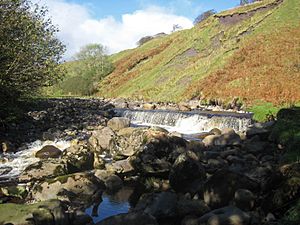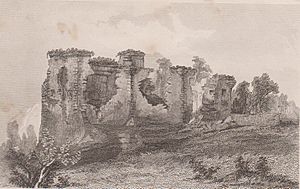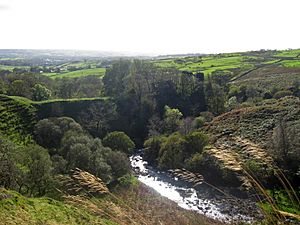Barony of Glengarnock facts for kids
The Barony of Glengarnock is a special historical area of land in Scotland. It's located in the county of Ayrshire. A "barony" was like a large estate or territory ruled by a "Baron" in the past. It was a bit like a small kingdom within a larger one.
The official document, called a Crown Charter, describes the lands of the Barony of Glengarnock. It includes many places like Glengarnock, Blackburn, Birkhill, and even a loch called Loch Tankard. These lands are spread across the areas of Kilbirnie and Ayrshire.
Contents
The Barony of Glengarnock
Early Owners
In the 1100s and 1200s, the De Morville family looked after these lands for the King. They were very important people in Scotland. Later, a family called Riddell owned the barony. They are thought to have come from another Riddell family in a place called Teviotdale.
The Cunninghams
Reginald Cunningham is believed to be the first owner of the Glengarnock barony from the Cunningham family. He was related to the Cunninghams of Glencairn. Reginald married Jonet Riddell, who was the daughter of the Riddell who owned Glengarnock. This happened around the mid-1200s.
William Cunningham of Glengarnock was another owner. Sadly, he was killed in a big battle called the Battle of Pinkie in 1547.
Sir James Cunningham owned the lands in 1609. He had some money problems. So, he gave the 'Lands of Glengarnock' to the people he owed money to. He then moved to Ireland to manage a large area of land that King James VI had given him. The people he owed money to then sold the estate to William Cunningham of Quarrelston.
William Cunningham of Quarrelston took over the property in 1654. He then sold it to Richard Cunningham. This Richard was the son of William Cunningham, who was a "Writer to the Signet." This was a legal job in Scotland.
Richard Cunningham was a strong supporter of the House of Stuart, the royal family at the time. He fought for them in the Wars of the Three Kingdoms (1638–1651). In 1648, Richard joined a royalist invasion of England but was defeated at the Battle of Preston (1648). He fought again in 1651 but was beaten by the army of Oliver Cromwell at the Battle of Worcester. Richard managed to escape capture and returned home to Glengarnock. He was buried in a special part of Kilbirnie Kirk church.
After the elder Richard died, his oldest son, also named Richard Cunningham, took over the barony.
The Lindsays
Patrick Lindsay bought Glengarnock Castle and its estate in 1677. He bought it from Richard Cuninghame, who was the last of the Cuninghame family to own it. Patrick Lindsay was the second son of a very important person, the 17th Earl of Crawford. The Lindsay family already owned the nearby Kilbirnie area. They got it when Patrick Lindsay married Margaret, the daughter of Sir John Crawford of Kilbirnie.
John Lindsay Crawford became the owner after his father Patrick in 1681. In 1703, Queen Anne gave John new titles. He became Viscount Garnock, Lord Kilbirnie, and more. In 1701, he decorated the special family area in the Kilbirnie church with 18 shields showing the Lindsay family history.
In 1708, John Lindsay Crawford's son, Patrick Lindsay Crawford, became the 2nd Viscount Garnock. He died in 1735 and was buried with his family in Kilbirnie Auld Kirk.
Patrick's oldest son, John Lindsay Crawford, became the 3rd Viscount after his father died. But John died when he was only 16. So, his brother George became the 4th Viscount.
George Lindsay Crawford inherited the titles and estates in 1749. He also became the 20th Earl of Crawford. He lived with his wife, Jean Hamilton, at Kilbirnie Castle. Sadly, Kilbirnie Castle was mostly destroyed by a fire in 1757. This forced George to move to another property he owned. George died in 1781.
After his father died in 1781, his oldest son, also named George Lindsay Crawford, inherited the lands and titles. This George was a major-general in the British Army. He died in 1808 and had no children or brothers who were still alive.
So, the Crawford-Lindsay estates, including the Barony of Glengarnock, went to Lady Mary Lindsay Crawford. After her, the barony passed to the Earls of Glasgow.
The Earls of Glasgow
In 1801, the title of the Barony of Glengarnock was officially given to George, Earl of Glasgow and Crawfurd Lindsay. A special document, sealed in Edinburgh in 1801, confirmed this. It clearly stated "All and whole the lands and barony of Glengarnock."
The Barony of Glengarnock stayed with the Earls of Glasgow for a long time. This is shown by several official records:
- In 1834, a document for the Earl of Glasgow.
- In 1845, a document for James Lindsay Crawford, Earl of Glasgow.
- In 1869, a legal order for George Frederick Lindsay Crawford, Earl of Glasgow, confirming he was the heir.
- In 1870, an official confirmation from the Prince of Wales (who is also the Great Steward of Scotland) for the Right Honourable George Frederick Lindsay Crawfurd, Earl of Glasgow.
The MacGregors
After 1889, the Barony was passed to Thomas Horatio Arthur Ernest Cochrane, Baron Cochrane of Cults. Then it went to Ralph Henry Vere Cochrane, Fourth Baron Cochrane of Cults. Finally, it came to the MacGregor family. They were the traditional landowners of Learagan in Rannoch. The current Baron of Glengarnock is the Much Honoured Robert S. MacGregor.
See also




